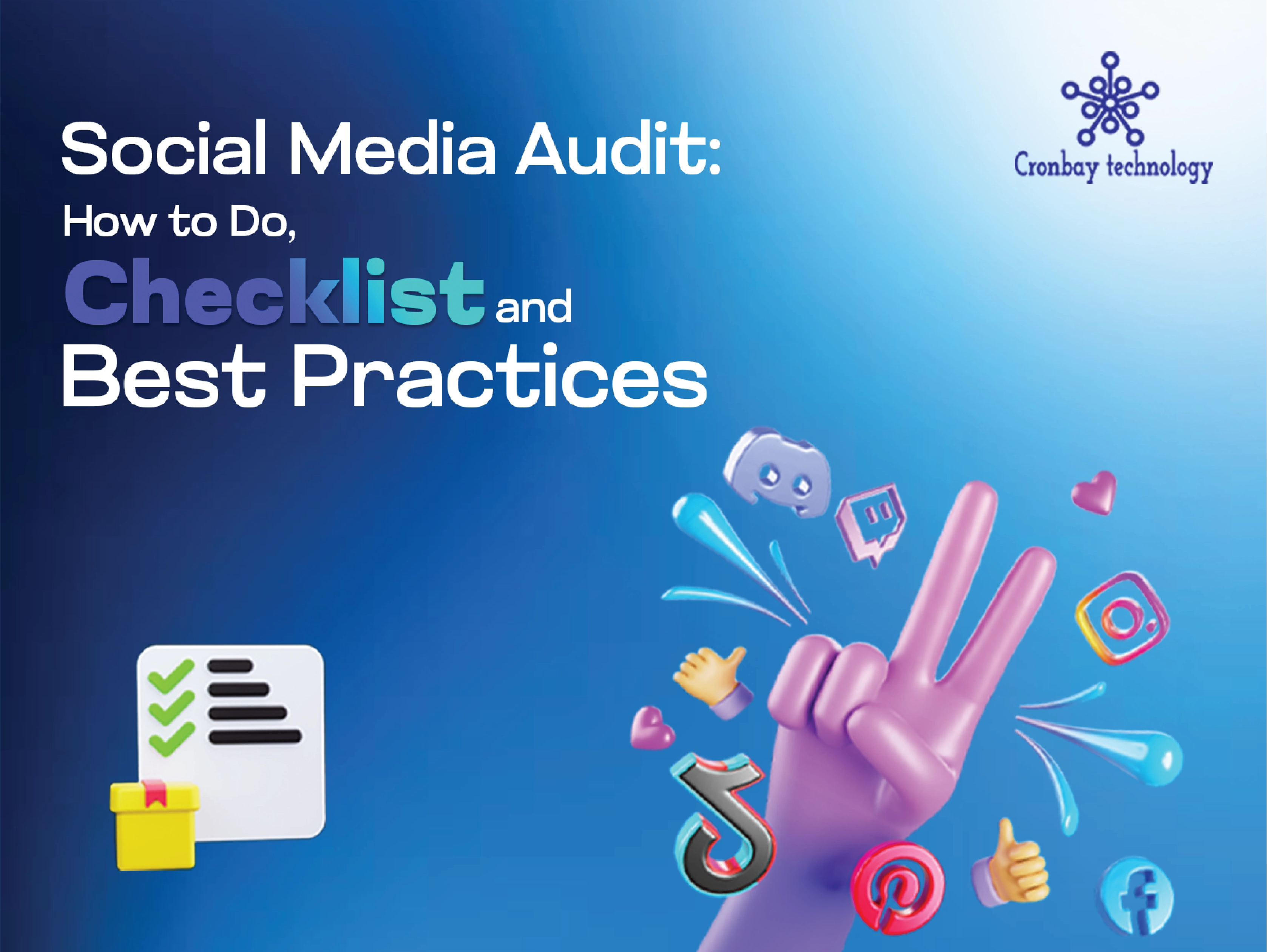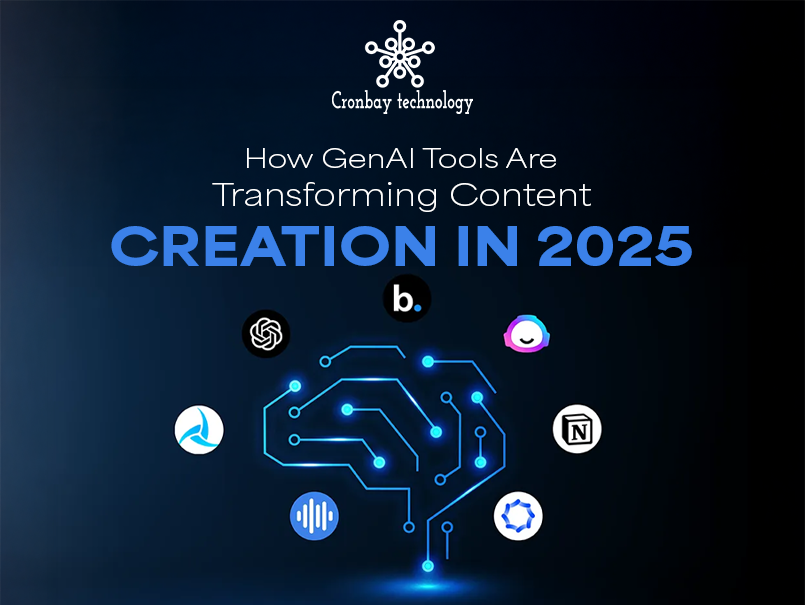A social media audit is a methodical examination of your brand in social media. It is about assessing your profiles, posts, engagement and audience so that each effort is in line with the business goals. Consider it as a health check-up on your social media platforms. With doctors reviewing your health report, a social media audit reveals the high-performers, weak areas, and new opportunities.
In 2025, social media is a crucial business tool rather than a branding tool. The focus of social media platforms has shifted from likes and shares to lead creation, client retention, and revenue growth. Most organizations continue to publish without knowing if their content strategy is actually working. A social media audit is conducted in this situation. At Cronbay Technologies, our goal is to help brands optimize return on investment by coordinating social media efforts with corporate goals. Let's investigate how you can, too.
What Makes A Social Media Audit Crucial?

A well-crafted social media audit gives you direction, clarity, and measurable results. This is why it will be crucial in 2025:
Connect Social Media to Business Goals: The purpose of social media networks is to increase sales, leads, and client loyalty. An audit helps you discover how your campaigns relate to certain KPIs, like conversions, site traffic, or retention, by conducting an audit.
Enhancing Social Channels ROI: With the rise in ad expenses, improving social channels' return on investment is crucial. By eliminating underperforming methods and focusing on high-impact initiatives, you can increase the return on investment (ROI).
Benefits of Frequent Auditing: Regular audits (every six months, every quarter, etc.) help keep your brand competitive by ensuring that:
- Coherency: The message, tone, and images are consistent across platforms.
- Optimization: You may continuously improve on what is working by using data-driven insights.
- Compliance: Your company's profile information is current with the relevant business data and conforms with platform specifications.
Key Components of a Social Media Audit

Here are some key components of a social media audit:
Profile and Branding Consistency: Your commerce websites are the online windows of your enterprise. Audit them to ensure:
- Photo and profile and cover photo are updated and professional.
- Contact and bio information and links are correct.
- Branding components (logos, fonts, tone) are the same over all platforms.
Trust and brand recognition are strengthened through consistency and can be applied in both LinkedIn and Instagram.
Content Performance Analysis: Your content is the pulse of your social presence. During an audit, ask:
- What posts most reached, shared, or saved?
- Which formats are used to make conversions reel, stories, or blogs?
- Do you post at the best times when your audience is most user friendly?
Track metrics using tools such as Meta Insights, LinkedIn Analytics or Sprout Social. Knowing how to perform well in content, you will be able to multiply winning formats and to cut the strategies that waste money.
Audience Learning and Participation: The audit can assist in discovering who your audience is:
- Demographics (age, place, gender).
- Behavioural insights (what they like, share, comment on).
- Positive or negative or neutral feedback analysis.
When the engagement rates are high, it usually means that you are resonating on the right note. However, when the level of engagement is low, the audit assists in narrowing down your content to suit the expectations of the audience.
How to Conduct a Social Media Audit (Step-by-Step)

An audit of your social media accounts doesn't have to be intimidating. By breaking it down into smaller steps, marketers may pinpoint the campaigns' strengths and weaknesses. The steps taken to carry out a social media audit in 2025 are as follows:
Collect Profile Data: Compiling data on all active (and inactive) accounts is the initial step. This ensures that you don't miss opportunities to showcase your brand. You should record profile names, biographies, handles, and URLs. You should also examine consistent branding elements, such as the tagline, profile image, and logo, and look for duplicate or outdated accounts.
Analyze Metrics on Different Platforms: After profiles are gathered, use performance metrics that are significant. Although KPIs will vary depending on your goals, some typical ones are as follows:
- Engagement metrics: Likes, comments, shares, and saves.
- Reach and impressions: The quantity of people who view your content.
- Brand authority metric: The pace at which followers are growing.
- Click-throughs or conversions: The number of clicks that go to your website or landing page.
Review Content Strategy: Then consider what you are posting and whether it is appealing to your audience. Ask: What forms (reels, carousels, stories, live videos) work best? Are posts fitting your brand voice and interest to the audience? Do you balance promotional, educative and involving content?
Assess Tools and Resources: The tools behind the strategy are also scrutinized in a good social media audit. Ask: Do you use the appropriate scheduling tools (Buffer, Hootsuite, HubSpot)? Are the analytics tools giving you the right insight? Do the team resources suffice to conduct campaigns on a regular basis?
In some cases inefficiencies do not necessarily entail content, but resource allocation.
Document Insights & Plan an Action: The last thing you need to do is to condense your findings into recommendations. You should keep what is working (and scale), flag areas with low performance (fix or drop), and have specific, quantifiable objectives.
When and How Often Should You Audit Your Social Media?

A social media audit frequency depends on the size of your brand, the intensity of your campaigns, and the rate of change in your industry.
- Monthly Audits: Best suited companies that have intensive campaigns and seasonal promotions. A monthly checkpoint will help you to notice swift drops in engagement or ROI.
- Quarterly Audits: These are best with brands that have consistent campaigns or have a small team. A review process after every three months will give sufficient information to monitor the trends and maximize strategies.
- Following Major Strategy Changes: Audit each time you implement a new campaign, introduce on a new platform, or rebrand. This assists you in monitoring performance at its infancy, and makes corrections promptly.
Social Media Audit Checklist
The following is a social media audit checklist 2025 quick version:
- Check and update all social profiles with branding and accuracy.
- Monitor follower acquisition, impressions and engagement.
- Determine the best performing content and posts.
- Compare performance in comparison with competitors.
- Check ad performance indicators of ROI.
- Assess reader profile and mood.
- Make sure profiles are in line with business goals and KPIs.
Hack: To keep a track of an audit, use Google sheets or Notion to keep one and update it every quarter.
Conclusion: Audits to Elevate Your Social Media Strategy
A Social Media Audit has ceased to be a luxury- nowadays, it is a mandatory element of any growth-driven marketing plan in 2025. A systematic review of your social profiles provide actionable information that can help you align your activity with actual business performance. Audits have value in helping to identify your weak points and determining areas of high performance. Companies that regularly audit (on a quarterly basis) experience quantifiable progress in:
- Relevancy of content and interactivity of audience.
- Coherent messaging of the brand.
- ROI on ad expenses and organic advertisement.
- Better positioning of competitors and market.
We would suggest that social media audits should be a regular event in your marketing calendar at Cronbay Technologies. Clients have gained up to 300% ROI and have experienced up to 60% engagement increment in the first three months by our data-driven digital marketing strategies.
FAQs
Frequently Asked Questions
1. What is a social media audit?
Ans. Social media audit may involve looking at the measurements of follower growth, engagement rates, content reach, hashtag performance, and competitor activity. The results can tell you that posts using a carousel can increase the engagement compared to one using a single image.
2. How many hours does social media audit take?
Ans. The duration will be dependent on the amount of platforms and the analysis complexity. An introductory audit might require 2-3 hours whereas a detailed audit might need several days. Cronbay Technologies normally takes 5-7 working days to conduct a full audit and deliver detailed and actionable insights.
3. How to conduct a media audit?
Ans. To audit social media, one has to go through the following steps:
- Add all active social accounts to a single list.
- Check profile information (bio, pictures, links) and consistency.
- Examine engagement and demographics of followers.
- Quantify KPIs such as reach, CTR, conversions and ROI.
- Compare with rivals.
- Prepare a social media audit checklist to record results and suggestions.
4. Which are the most appropriate social media audit tools?
Ans. The most useful tools are:
- Hootsuite & Sprout Social: To engage and analyse.
- Google Analytics: To track traffic and conversion.
- SEMrush & BuzzSumo: To benchmark the competition.
- Meta Business Suite and LinkedIn Analytics: To get platform specific performance.
See What's Trending in Digital Marketing World
Do you want to know what are the latest developments in the digital world? Catch the detailed insights with our latest blogs.





